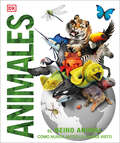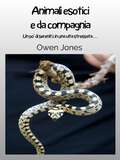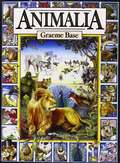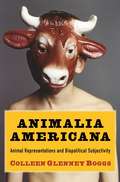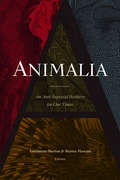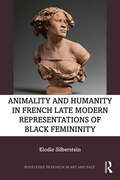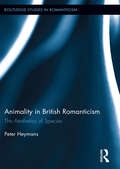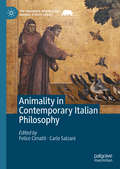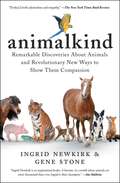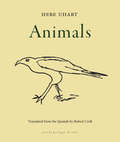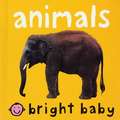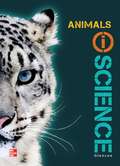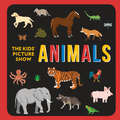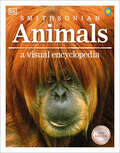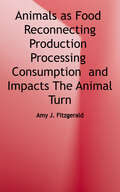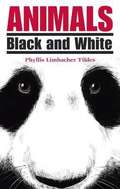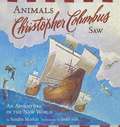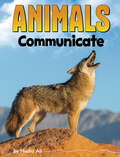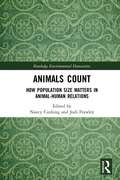- Table View
- List View
Animales que se parecen (¡Arriba la Lectura!, Big Book Unit 2 #7)
by Robin BernardNIMAC-sourced textbook
Animales que viven bajo la tierra (¡Arriba la Lectura!, Level I #61)
by Debbie CroftNIMAC-sourced textbook. Hay muchos animales que viven bajo la tierra, como conejos, ardillas, ranas y lombrices. Aprende cómo viven estos animales.
Animales que viven en el bosque: Osos negros (¡Arriba la Lectura!, Big Book Unit 2 #9)
by JoAnn MackenNIMAC-sourced textbook
Animales: El reino animal como nunca lo habías visto (DK Knowledge Encyclopedias)
by DKEl reino animal como nunca antes lo habías vistoRepleto de ilustraciones en 3D, Animales acerca al lector a un mundo en constante evolución para descubrir cómo vive y cómo se relaciona con su entorno cada habitante del planeta.Animales está lleno de divertidas curiosidades y datos relevantes de especies de todo el reino animal: desde las alas de un espectacular albatros a la majestuosidad del tiburón blanco, el libro es un repaso por todas las especies que conforman cada ecosistema por remoto que sea.Descubre todo tipo de animales, desde la diminuta pulga de agua hasta la gran ballena azul. Observa la vida animal en sus detalles más recónditos: las brillantes escamas del ala de la mariposa, el cortante filo del diente del tigre, el espolón venenoso del ornitorrinco... Aprende cómo se comunican las hormigas, cómo los pingüinos protegen a sus polluelos o por qué cambian de color los camaleones. ¡Prepárate para sumergirte de lleno en el reino animal!
Animali esotici e da compagnia: Un po’ di serenità in una vita stressata… (Come... #31)
by Owen JonesSpero che tu possa trovare queste informazioni utili ed efficaci. Le informazioni contenute in questo ebook riguardano vari aspetti degli animali esotici da compagnia e non, divisi in 20 capitoli da 500-600 parole ciascuno. Spero che questo possa essere interessante per gli amanti degli animali. Ti autorizzo inoltre ad utilizzare il contenuto di quest’opera per il tuo sito internet, blog o newsletter, anche se ti consiglio di rielaborare il tutto con parole tue. Potresti anche suddividere il libro e rivenderne gli articoli, considerando che l’unico diritto di cui non disponi è quello di presentare o rivendere il libro così come ti è stato consegnato.
Animalia
by Graeme BaseAn alphabet book with fantastic and detailed pictures, bearing such labels as Lazy lions lounging in the local library..
Animalia Americana: Animal Representations and Biopolitical Subjectivity (Critical Perspectives on Animals: Theory, Culture, Science, and Law)
by Colleen BoggsColleen Glenney Boggs puts animal representation at the center of the making of the liberal American subject. Concentrating on the formative and disruptive presence of animals in the writings of Frederick Douglass, Edgar Allan Poe, and Emily Dickinson, Boggs argues that animals are critical to the ways in which Americans enact their humanity and regulate subjects in the biopolitical state. <P><P>Biopower, or a politics that extends its reach to life, thrives on the strategic ambivalence between who is considered human and what is judged as animal. It generates a space of indeterminacy in which animal representations intervene to define and challenge the parameters of subjectivity. The renegotiation of the species line produces a tension that is never fully regulated. Therefore, as both figures of radical alterity and the embodiment of biopolitics, animals are simultaneously exceptional and exemplary to the biopolitical state. An original contribution to animal studies, American studies, critical race theory, and posthumanist inquiry, Boggs thrillingly reinterprets a long and highly contentious human-animal history.
Animalia: A to Z
by Christal Lorice BaileyThere are so many animals in the world. We have to think about how we as humans are impacting their world. Every animal deserves to survive and thrive, and with human help, they can do so. This book is just a sampling of all the amazing creatures found in the diverse habitats on our beautiful planet Earth.
Animalia: An Anti-Imperial Bestiary for Our Times
by Antoinette Burton and Renisa MawaniFrom yaks and vultures to whales and platypuses, animals have played central roles in the history of British imperial control. The contributors to Animalia analyze twenty-six animals—domestic, feral, predatory, and mythical—whose relationship to imperial authorities and settler colonists reveals how the presumed racial supremacy of Europeans underwrote the history of Western imperialism. Victorian imperial authorities, adventurers, and colonists used animals as companions, military transportation, agricultural laborers, food sources, and status symbols. They also overhunted and destroyed ecosystems, laying the groundwork for what has come to be known as climate change. At the same time, animals such as lions, tigers, and mosquitoes interfered in the empire's racial, gendered, and political aspirations by challenging the imperial project’s sense of inevitability. Unconventional and innovative in form and approach, Animalia invites new ways to consider the consequences of imperial power by demonstrating how the politics of empire—in its racial, gendered, and sexualized forms—played out in multispecies relations across jurisdictions under British imperial control. <P><P>Contributors. Neel Ahuja, Tony Ballantyne, Antoinette Burton, Utathya Chattopadhyaya, Jonathan Goldberg-Hiller, Peter Hansen, Isabel Hofmeyr, Anna Jacobs, Daniel Heath Justice, Dane Kennedy, Jagjeet Lally, Krista Maglen, Amy E. Martin, Renisa Mawani, Heidi J. Nast, Michael A. Osborne, Harriet Ritvo, George Robb, Jonathan Saha, Sandra Swart, Angela Thompsell
Animality and Humanity in French Late Modern Representations of Black Femininity (Routledge Research in Art and Race)
by Elodie SilbersteinThis volume examines the evolution of the depictions of black femininity in French visual culture as a prism through which to understand the Global North’s destructive relationship with the natural world. Drawing on a broad spectrum of archives extending back to the late 18th century – paintings, fashion plates, prints, photographs, and films – this study traces the intricate ways a patriarchal imperialism and a global capitalism have paired black women with the realm of nature to justify the exploitation both of people and of ecosystems. These dehumanizing and speciesist strategies of subjugation have perpetuated interlocking patterns of social injustice and environmental depletion that constitute the most salient challenges facing humankind today. Through a novel approach that merges visual studies, critical race theory, and animal studies, this interdisciplinary investigation historicizes the evolution of the boundaries between human and non-human animals during the modern period. The book will be of interest to scholars working in art history, visual studies, critical race theory, colonial and post-colonial studies, animal studies, and French studies.
Animality in British Romanticism: The Aesthetics of Species (Routledge Studies in Romanticism)
by Peter HeymansThe scientific, political, and industrial revolutions of the Romantic period transformed the status of humans and redefined the concept of species. This book examines literary representations of human and non-human animality in British Romanticism. The book’s novel approach focuses on the role of aesthetic taste in the Romantic understanding of the animal. Concentrating on the discourses of the sublime, the beautiful, and the ugly, Heymans argues that the Romantics’ aesthetic views of animality influenced—and were influenced by—their moral, scientific, political, and theological judgment. The study reveals how feelings of environmental alienation and disgust played a positive moral role in animal rights poetry, why ugliness presented such a major problem for Romantic-period scientists and theologians, and how, in political writings, the violent yet awe-inspiring power of exotic species came to symbolize the beauty and terror of the French Revolution. Linking the works of Wordsworth, Blake, Coleridge, Byron, the Shelleys, Erasmus Darwin, and William Paley to the theories of Immanuel Kant and Edmund Burke, this book brings an original perspective to the fields of ecocriticism, animal studies, and literature and science studies.
Animality in Contemporary Italian Philosophy (The Palgrave Macmillan Animal Ethics Series)
by Carlo Salzani Felice CimattiThis volume provides an overview of contemporary Italian philosophy from the perspective of animality. Its rationale rests on two main premises: the great topicality of both Italian contemporary philosophy (the so-called “Italian Theory”) and of the animal question (the so-called “animal turn” in the humanities and the social sciences) in the contemporary philosophical panorama. The volume not only intersects these two axes, illuminating Italian Theory through the animal question, but also proposes an original thesis: that the animal question is a central and founding issue of contemporary Italian philosophy. It combines historical-descriptive chapters with analyses of the theme in several philosophical branches, such as biopolitics, Posthumanism, Marxism, Feminism, Antispeciesism and Theology, and with original contributions by renowned authors of contemporary Italian (animal) philosophy. The volume is both historical-descriptive and speculative and is intended for a broad academic audience, embracing both Italian studies and Animal studies at all levels.
Animalkind: Remarkable Discoveries About Animals and Revolutionary New Ways to Show Them Compassion
by Gene Stone Ingrid NewkirkThe founder and president of PETA, Ingrid Newkirk, and bestselling author Gene Stone explore the wonders of animal life and offer tools for living more kindly toward them.In the last few decades, a wealth of new information has emerged about who animals are—intelligent, aware, and empathetic. Studies show that animals are astounding beings with intelligence, emotions, intricate communications networks, and myriad abilities. In Animalkind, Ingrid Newkirk and Gene Stone present these findings in a concise and awe-inspiring way, detailing a range of surprising discoveries: that geese fall in love and stay with a partner for life, that fish &“sing&” underwater, and that elephants use their trunks to send subsonic signals, alerting other herds to danger miles away. Newkirk and Stone pair their tour of the astounding lives of animals with a guide to the exciting new tools that allow humans to avoid using or abusing animals as we once did. They show readers what they can do in their everyday lives to ensure that the animal world is protected from needless harm. Whether it&’s medicine, product testing, entertainment, clothing, or food, there are now better options to all the uses animals once served in human life. We can substitute warmer, lighter faux fleece for wool, choose vegan versions of everything from shrimp to sausage and milk to marshmallows, reap the benefits of medical research that no longer requires monkeys to be caged in laboratories, and scrap captive orca exhibits and elephant rides for virtual reality and animatronics. Animalkind is a fascinating study of why our fellow living beings deserve our respect, and moreover, the steps every reader can take to put this new understanding into action.
Animals
by HEBE UHARTFrom the winner of Argentina's National Endowment of the Arts Prize and the Manuel Rojas Ibero-American Narrative Prize comes this series of reflections on critters and their natural or not-so-natural habitats.Hebe Uhart's Animals tells of piglets that snack on crackers, parrots that rehearse their words at night, southern screamers that lurk at the front door of a decrepit aunt's house, and, of course, human animals, whose presence is treated with the same inquisitive sharpness and sweetness that marks all of Uhart's work. Animals is a joyous reordering of attention towards the beings with whom we share the planet. In prose that tracks the goings on of creatures who care little what we do or say, a refreshing humility emerges, and with it a newfound pleasure in the everyday. Watching a whistling heron, Uhart writes, "that rebellious crest gives it a lunatic air." Birds in the park and dogs in the street will hold a different interest after reading Uhart's blissful foray into playful zoology.
Animals
by Priddy BooksPerfect for babies and toddlers. The combination of colorful pictures and simple words help build a child's vocabulary.
Animals (Glenco Science-Unit #3)
by Mcgraw Hill Education"This Glenco Science Unit 3 Animals textbook contains chapters on Animal Diversity, Animal Structure and Function, Animal Behavior and Reproduction.
Animals (The Kids' Picture Show)
by Chieri DeGregorio Steve DeGregorioGet ready for an animal adventure with your little explorer! The Kids' Picture Show books, inspired by the hugely popular YouTube channel, introduce young readers to first words in cool 8-bit style.This sturdy board book, packed with images of animals, is the perfect introduction to creatures from around the world for babies and toddlers. The 8-bit illustration style makes the book even more fun and accessible for young children, and will also appeal to parents, grandparents, and everyone who has played classic video arcade games.
Animals A Visual Encyclopedia
by DKSee the animal kingdom up close and personal in this ultimate reference book for children.Filled with more than 700 photographs, habitat maps, and illustrations, Animals A Children's Encyclopedia helps children and parents learn about the rich variety of animal life on our planet.Meet the deadliest, largest, friendliest, fastest and downright strangest animals known to man, and discover what they look like, where they live, what they do, what they eat and what life is like for their young. From the latest research to recent numbers on populations, this book gives you all the information you need about animals on land, in water, and in the air.This animal encyclopedia for children offers:- An introduction to the animal kingdom through photographs of hundreds of animals accompanied by informative text.- A new and updated edition of a popular title in the Children&’s Encyclopedia series, which has sold millions of copies worldwide.- A global scope of information, covering all key habitats and continents from around the world.At a time in history when climate change and habitat loss are profoundly affecting animals, this book helps educate children about all the creatures in the world that are at risk of vanishing forever.From the same series as the New Children's Encyclopedia and DK children's encyclopedias of Science, Art, and Geography (among others), this updated animal encyclopedia is full of valuable reference information for children, parents, and educators. Learn all about the world one subject at a time!If you like Animals A Children&’s Encyclopedia then why not complete the collection? Part of popular New Children&’s Encyclopedia series, avid readers can enjoy Legends and Sacred Stories, Art, Myths, and Ocean A Children&’s Encyclopedia.
Animals Armed for Survival (Into Reading, Level Q #6)
by Stanford MakishiNIMAC-sourced textbook. Animals in the wild have different ways of protecting themselves. What do porcupines, turtles, and alligators have in common? Read the book to find out.
Animals As Food: (Re)connecting Production, Processing, Consumption, and Impacts
by Amy J. FitzgeraldEvery day, millions of people around the world sit down to a meal that includes meat. This book explores several questions as it examines the use of animals as food: How did the domestication and production of livestock animals emerge and why? How did current modes of raising and slaughtering animals for human consumption develop, and what are their consequences? What can be done to mitigate and even reverse the impacts of animal production? With insight into the historical, cultural, political, legal, and economic processes that shape our use of animals as food, Fitzgerald provides a holistic picture and explicates the connections in the supply chain that are obscured in the current mode of food production. Bridging the distance in animal agriculture between production, processing, consumption, and their associated impacts, this analysis envisions ways of redressing the negative effects of the use of animals as food. It details how consumption levels and practices have changed as the relationship between production, processing, and consumption has shifted. Due to the wide-ranging questions addressed in this book, the author draws on many fields of inquiry, including sociology, (critical) animal studies, history, economics, law, political science, anthropology, criminology, environmental science, geography, philosophy, and animal science.
Animals Black And White
by Phyllis TildesPhyllis Limbacher Tildes deftly delivers the pieces to put together these pattern puzzles. First take a peek at each black-and-white animal and read a short clue. Can you guess who it is? Turn the page and the answer is revealed in vivid color. Animal facts are included at the end.
Animals Christopher Columbus Saw
by Sandra Markle Jamel AkibIn this series by award-winning author Sandra Markle, famous explorers take a back seat to the animals they encountered along the way. While nothing about Christopher Columbus' journey was expected, he couldn't have imagined feasting on roasted lizard! Through nimble writing and beautiful paintings, this series casts the past in a whole new light!
Animals Communicate (Animal Societies Ser.)
by Nadia AliWhales whistle, fireflies glow, and skunks spray—that’s how they communicate! Find out how mammals, reptiles, birds, and other animals send messages and signals to stay safe, make friends, and care for their young. Accessible and fun K–3 level information reveals the animal world to young readers and researchers in this Pebble Explore title from the Animal Societies series.
Animals Count: How Population Size Matters in Animal-Human Relations (Routledge Environmental Humanities)
by Nancy Cushing Jodi FrawleyWhether their populations are perceived as too large, just right, too small or non-existent, animal numbers matter to the humans with whom they share environments. Animals in the right numbers are accepted and even welcomed, but when they are seen to deviate from the human-declared set point, they become either enemies upon whom to declare war or victims to be protected. In this edited volume, leading and emerging scholars investigate for the first time the ways in which the size of an animal population impacts how they are viewed by humans and, conversely, how human perceptions of populations impact animals. This collection explores the fortunes of amphibians, mammals, insects and fish whose numbers have created concern in settler Australia and examines shifts in these populations between excess, abundance, equilibrium, scarcity and extinction. The book points to the importance of caution in future campaigns to manipulate animal populations, and demonstrates how approaches from the humanities can be deployed to bring fresh perspectives to understandings of how to live alongside other animals.

